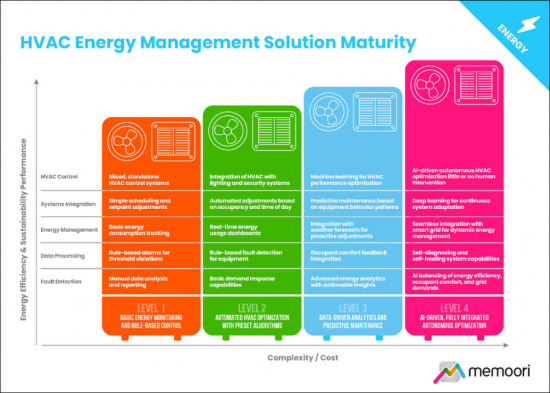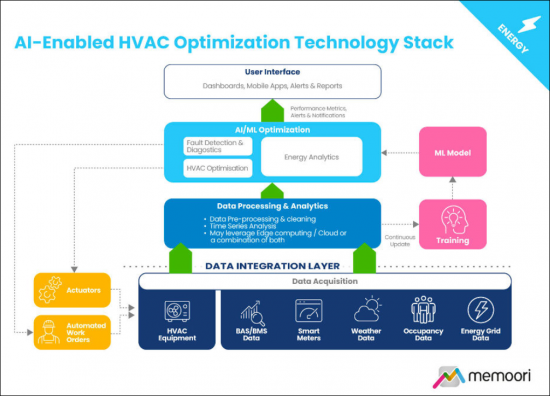 |
市場調查報告書
商品編碼
1566486
商業大樓用HVAC最佳化能源管理軟體的全球市場 - 市場規模,競爭情形(2024年~2029年)Energy Management Software for HVAC Optimization in Commercial Buildings - Market Sizing & Competitive Landscape 2024-2029 |
||||||
範例視圖

全球商業建築 HVAC 優化能源管理軟體市場規模預計將從 2023 年 36.5 億美元的基準值成長到 2029 年達到 58.3 億美元。
相對於其占地面積,資料中心佔市場收入的很大一部分,佔 2024 年 HVAC 優化軟體總收入的 11.4%(4.49 億美元)。 HVAC 冷卻可佔資料中心總能源消耗的 40%,因此高效的 HVAC 管理至關重要。資料中心中人工智慧驅動的 HVAC 解決方案可根據伺服器負載等級、外部氣候條件和內部溫度等即時資料動態調整冷卻輸出。
由於技術進步、監管壓力以及對能源效率需求的認識不斷提高,商業建築 HVAC 優化的能源管理軟體市場預計在未來五年內將顯著增長。
本報告研究和分析了商業建築暖通空調優化市場的全球能源管理軟體,提供了市場規模、趨勢和推動因素、挑戰和障礙以及競爭格局等資訊。我們也仔細研究了人工智慧驅動的能源管理技術如何改變暖通空調系統的運作方式,提高運作效率和永續性。
樣品view

能源管理軟體公司特色範例
|
|
目錄
序文
調查範圍
調查手法
定義
第1章 簡介
第2章 核心技術
- 感測器、連網設備、物聯網
- 分析、人工智慧、機器學習
- 邊緣/雲端運算
- 使用人工智慧的 HVAC 優化技術堆疊
第3章 商業大樓的能源管理的現狀
- 商業建築能源消耗概覽
- 商業建築的能源使用模式
- 商業建築的二氧化碳排放量
- 技術採用率
- HVAC 能源管理解決方案成熟度模型
第4章 主要使用案例與用途
- 提高能源績效
- 減少二氧化碳排放
- 預測性維護與故障偵測
- 基於佔用情況的 HVAC 控制
- 根據季節和天氣進行最佳化
- 室內空氣品質 (IAQ) 和 HVAC 優化
第5章 垂直市場用途和機會
- 垂直市場概要
- 辦公室
- 零售
- 飯店·食品服務
- 倉庫
- 資料中心
第6章 市場趨勢與促進因素
- 世界能源情勢
- 再生能源、能源轉型
- 建築與電網整合
- 監管與政策環境
- 經濟因素與房地產趨勢
- 工作場所動態的變化
- 都市化與智慧城市舉措
- 永續發展、ESG、綠色金融
- 認證和行業標準
第7章 課題與阻礙
- 財務障礙
- 與舊系統集成
- 技能與勞動力障礙
- 資料隱私和安全
- 改造及危險房
第8章 全球市場的預測(2024年~2029年)
- 全球市場的預測
- 市場明細:各業界
第9章 地區市場明細與分析
- 市場明細:各地區
- 地區特有的市場促進因素與阻礙
第10章 活用了AI的HVAC軟體的競爭情形
- 企業的地區分佈
- 企業的分佈:各規模
- 企業的分佈:各年數
第11章 主要企業的策略性定位
- 大樓自動化企業
- HVAC的專家
- 創新的Start-Ups和新興企業
第12章 投資趨勢與M&A
- 合併和收購
- 夥伴關係和合作
- 投資概要
- 地理投資趨勢
- 值得注意的投資交易
This report is a new 2024 study that provides a detailed market forecast to 2029, broken down by region and vertical market.
In today's complex commercial real estate landscape, energy management has become a critical focus for property and facilities managers. Optimizing energy use is not just about lowering costs, it has become a key factor in achieving sustainability and resource efficiency.
This new research takes an in-depth look at how artificial intelligence-driven energy management technologies will transform the way HVAC systems operate, enhancing both operational efficiency and sustainability. The report includes, at no extra cost, a spreadsheet containing the data from the report and high-resolution presentation charts showing the key findings. It is the first in a 2-part series of reports, with the second report on building-to-grid interaction software being published later this year.
Both these reports are included in Memoori's 2024 Premium Subscription Service, which also gives access to our chatbot AIM, where you can query all our research using the power of Large Language Models (LLMs).
SAMPLE VIEW

HVAC Energy Management Solution Maturity Model
To better understand the landscape of HVAC energy management solutions and their relative maturity, Memoori has developed a model categorizing these solutions into four distinct tiers.
- Tier 1 represents basic energy monitoring and rule-based control, with limited automation and integration.
- Tier 2 introduces semi-automated control and basic data-driven analytics, allowing for more comprehensive energy management.
- Tier 3 transitions to data-driven optimization incorporating machine learning and predictive analytics, enabling dynamic optimization based on real-time and predictive data.
- Tier 4 represents the pinnacle of HVAC energy management, with predominantly autonomous and AI-driven systems capable of optimizing performance without human intervention.
Based on an assessment of available data on technology adoption, the report develops a theoretical model of the global distribution across the HVAC Energy Management Solution Maturity tiers.
Scope
This report focuses specifically on next-generation software solutions that leverage AI and IoT technologies to track, analyze, automate, and optimize HVAC energy consumption and performance. Software solutions included in the scope of the research for this report include:
- Software solutions directly supporting HVAC automation and optimization.
- Energy performance optimization and carbon emissions reduction solutions.
- Automated HVAC fault detection & diagnostics solutions.
- Data integration and interoperability solutions integral to HVAC optimization.
- AI-enabled occupancy-based HVAC control solutions.
Technology out of the scope of this report includes, broader energy management systems incorporating non-HVAC elements, energy data visualization and reporting tools, sustainability or ESG solutions, grid interaction software, and any hardware revenues related to energy management.
WITHIN ITS 227 PAGES AND 19 CHARTS, THE REPORT FILTERS OUT ALL THE KEY FACTS AND DRAWS CONCLUSIONS, SO YOU CAN UNDERSTAND EXACTLY HOW ENERGY MANAGEMENT TECHNOLOGY IS IMPACTING HVAC SYSTEMS AND WHY;
- The market for Energy Management Software for HVAC Optimization in Commercial Buildings is projected to grow from a baseline value of $3.65 billion in 2023 to $5.83 billion by 2029, representing a compound annual growth rate (CAGR) of 8.1%. Our projection accounts for regional disparities in adoption rates, macroeconomic influences, and technology-driven shifts to deliver a comprehensive and realistic market outlook.
- Data centers account for an outsized proportion of market revenues relative to their floorspace, representing 11.4% of overall HVAC optimization software revenues ($449 million) in 2024. HVAC cooling can account for up to 40% of a data center's total energy use, making efficient HVAC management crucial. AI-driven HVAC solutions in data centers can dynamically adjust cooling outputs based on real-time data such as server load levels, external weather conditions, and internal temperatures.
- The market for Energy Management Software for HVAC Optimization in Commercial Buildings is poised for significant growth over the next five years, driven by technological advancements, regulatory pressures, and increasing awareness of the need for energy efficiency.
This report provides valuable information to companies so they can improve their strategic planning exercises AND look at the potential for developing their energy management software business. The final part of the report provides a thorough competitive landscape analysis, profiling key players, market leaders, and emerging startups. This includes an overview of strategic partnerships, mergers, and acquisitions in the sector.
SAMPLE VIEW

The infographic above visualizes the flows of data that occur between different technologies to enable the AI HVAC Optimization Technology Stack. By integrating AI, IoT, and data analytics, this system can dynamically enhance HVAC performance, reflecting the core concepts discussed in this report.
WHO SHOULD BUY THIS ENERGY MANAGEMENT REPORT?
The information contained in this report will be of value to all those engaged in managing, operating, and investing in Commercial Buildings (and their Advisors) around the world. The report aims to help stakeholders make informed decisions that will drive the future of HVAC optimization and energy management.Energy Management Software Companies Mentioned INCLUDE (but NOT limited to):
|
|
Table of Contents
Preface
Research Scope
Methodology
Definitions
1. Introduction
- 1.1. The Evolution of Building Energy Management Systems (BEMS)
- 1.2. Factors Influencing Energy Consumption in HVAC
2. Core Technologies
- 2.1. Sensors, Connected Devices, and IoT
- 2.2. Analytics, AI & Machine Learning
- 2.3. Edge and Cloud Computing
- 2.4. The AI-Enabled HVAC Optimization Technology Stack
3. The Current State of Energy Management in Commercial Buildings
- 3.1. Overview of Energy Consumption in Commercial Buildings
- 3.2. Energy Use Patterns in Commercial Buildings
- 3.3. Carbon Emissions from Commercial Building
- 3.4. Technology Adoption Rates
- 3.5. HVAC Energy Management Solution Maturity Model
4. Key Use Cases and Applications
- 4.1. Energy Performance Improvements
- 4.2. Carbon Emissions Reduction
- 4.3. Predictive Maintenance and Fault Detection
- 4.4. Occupancy-Based HVAC Control
- 4.5. Seasonal and Weather-Driven Optimization
- 4.6. Indoor Air Quality (IAQ) and HVAC Optimization
5. Vertical Market Applications & Opportunities
- 5.1. Vertical Market Overview
- 5.2. Offices
- 5.3. Retail
- 5.4. Hospitality & Food Services
- 5.5. Warehouses
- 5.6. Data Centers
6. Market Trends & Drivers
- 6.1. Global Energy Landscape
- 6.2. Renewables and the Energy Transition
- 6.3. Building-to-Grid Integration
- 6.4. Regulatory and Policy Landscape
- 6.5. Economic Factors and Real Estate Trends
- 6.6. Changing Workplace Dynamics
- 6.7. Urbanization and Smart City Initiatives
- 6.8. Sustainability, ESG, and Green Financing
- 6.9. Certifications and Industry Standards
7. Challenges and Barriers
- 7.1. Financial Barriers
- 7.2. Integration with Legacy Systems
- 7.3. Skills and Workforce Barriers
- 7.4. Data Privacy and Security
- 7.5. Retrofit and Ageing Building Stocks
8. Global Market Forecasts 2024 to 2029
- 8.1. Global Market Forecasts
- 8.2. Market Breakdown by Vertical
9. Regional Market Breakdown & Analysis
- 9.1. Regional Market Breakdown
- 9.2. Region Specific Market Drivers & Barriers
10. The Competitive Landscape in AI-Enabled HVAC Software
- 10.1. Regional Distribution of Companies
- 10.2. Distribution of Companies by Size
- 10.3. Distribution of Companies by Age
11. The Strategic Positioning of Key Players
- 11.1. Building Automation Firms
- 11.2. HVAC Specialists
- 11.3. Innovative Startups and Emerging Players
12. Investment Trends and M&A
- 12.1. Mergers and Acquisitions
- 12.2. Partnerships & Alliances
- 12.3. Investments Summary
- 12.4. Geographic Investment Trends
- 12.5. Notable Investment Deals
List of Charts and Figures
- Fig 2.1 - Installed Base of IoT Devices in Commercial Smart Buildings 2020 - 2028 (Millions)
- Fig 2.2 - The Internet of Things in Smart Commercial Buildings 2023 v5.1
- Fig 2.3 - AI & Machine Learning Techniques and their Smart Building Applications
- Fig 2.4 - AI-Enabled HVAC Optimization Technology Stack
- Fig 3.1 - Share of Buildings in Total Final Energy Consumption and Global Energy Emissions in 2022
- Fig 3.2 - Major Fuels Consumption by End Use in US Commercial Buildings 2018
- Fig 3.3 - Total Final Energy Consumption in Buildings by Region 2010 to 2022
- Fig 3.4 - Share of U.S. Commercial Floorspace that Incorporates Selected Sensor and Control Technologies 2012 to 2050
- Fig 3.5 - HVAC Energy Management Solution Maturity
- Fig 4.1 - AI's Energy-Saving Potential by Application Area
- Fig 5.1 - HVAC Energy Intensity by Building Type in US Buildings 2018
- Fig 6.1 - Commercial Sector Construction Growth Estimates by Region 2024 to 2029
- Fig 8.1 - The Global Market for Energy Management Software for HVAC Optimization in Commerical Buildings 2023 to 2029
- Fig 8.2 - Energy Management Software for HVAC Optimization by Vertical Market 2024
- Fig 9.1 - Energy Management Software for HVAC Optimization by Region 2024 to 2029
- Fig 10.1 - Regional Distribution of HVAC Optimization Software Companies
- Fig 10.2 - Distribution of HVAC Optimization Software Companies by Size, Number of Employees
- Fig 10.3 - Distribution of HVAC Optimization Software Companies by Age
- Fig 12.1 - Global Investment Landscape of HVAC Optimization Software Companies, Average Funding and Number of Funded Companies in Leading Countries











